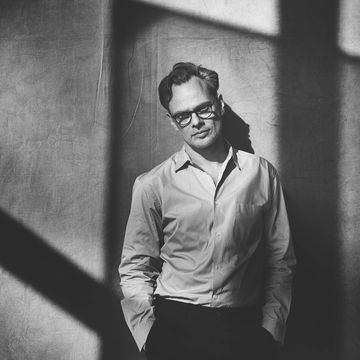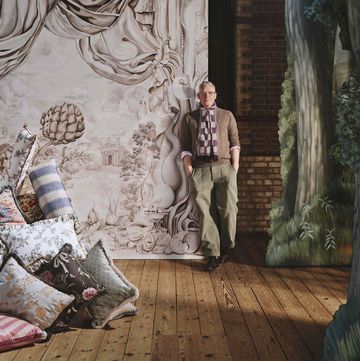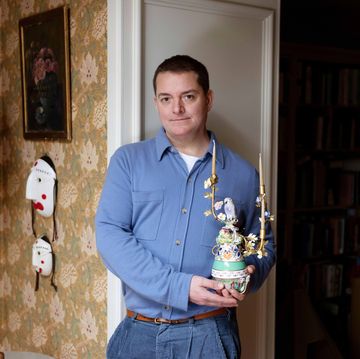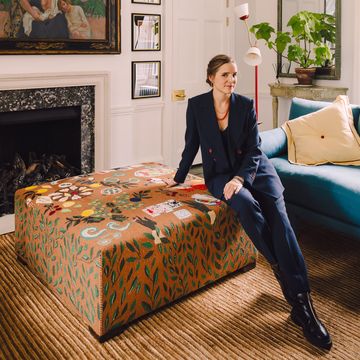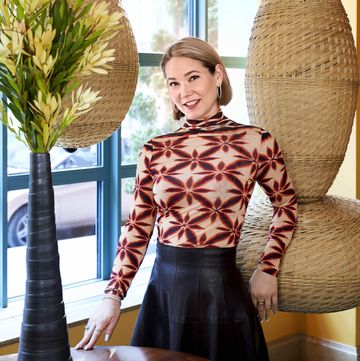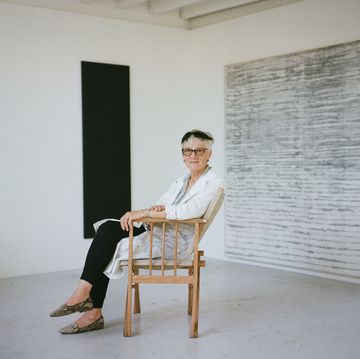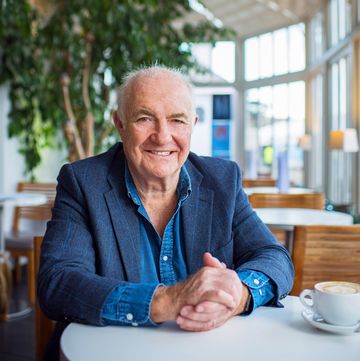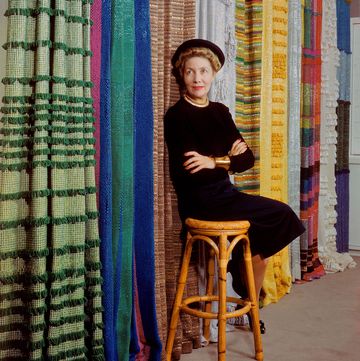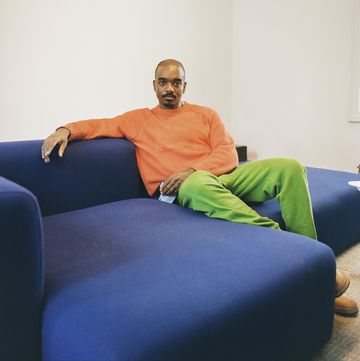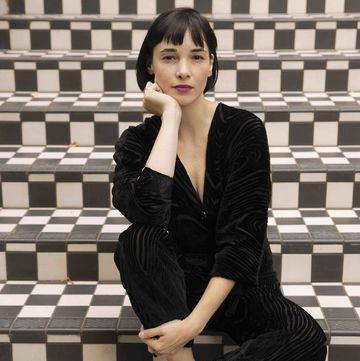Everyone knows the simple joy to be found in dropping a bunch of flowers in a vase, but his group of rising stars is pushing the art of flower arranging in exciting directions by experimenting with new - and forgotten - varieties and unconventional colour combinations, shapes and forms. They shared some industry secrets for making the most of your blooms, as well as revealing the flowers they love to display in their own homes...
Rollo Skinner
This darling of the fashion world draws inspiration for his show stopping displays from the beauty and chaos of nature
A fortuitous trip to Tesco just before the pandemic turned Rollo Skinner into a botanical set designer. ‘I was struggling with my job and mental health and bought some flowers on a whim,’ he explains. ‘I came home and was transfixed, the noise in my head stopped for a moment.’
He left his career as an art director to study at the London Flower School and has worked solidly since, for clients including Gucci, Soho House and Acqua di Parma. Skinner describes his aesthetic as ‘naturalistic, wild and romantic but always with a quirk’. ‘I play with very considered colour palettes, but I like to surprise myself,’ he adds.
Whether it’s the scent of spring blooms or autumn’s vivid palette, he finds inspiration all year round. ‘I love the late-winter moment of relief and joy from the first snowdrops and hellebores; I’m constantly excited by nature.’
His most ambitious project to date was for SS Daley’s London Fashion Week show last autumn. ‘I had worked with him before, creating a wintery sheep meadow at Matchesfashion’s Carlos Place,’ he recalls. ‘There was a last-minute change and I had to design an homage to Sissinghurst Castle Gardens in a week, and instruct a brilliant team to create it remotely while I was teaching my workshops at Soho Farmhouse’s Festival.’
Describing his interiors style as ‘quite 70s and minimal, lots of wood and earth tones,’ he tends towards larger arrangements of dried flowers in his own home. He advises beginners to follow their instincts and have fun: ‘Think about how things grow in nature by grouping flowers together and giving everything its own space.’
Skinner loves to learn from his students. ‘At a workshop I held, one girl combined catmint and sedum – such a delicate textural quality. I still can’t get it out of my head.’ He might draw on music, a story, colour or texture to inform his work, but ultimately it’s nature itself (‘the way things grow, the harmony and the discord’) that drives him.
Despite avoiding Instagram trends, he approves of one: ‘Carnations or dianthus are seen as petrol-station flowers but they are beautiful and come in so many different varieties. They’ve already made a comeback, but they’re only going to become trendier. I’m always rooting for the underdogs.’ @rolloskinner
Hazel Gardiner
Seasonality is key for this florist, who believes bouquets can be more than pretty – they can convey deep feeling
Hazel Gardiner’s route into floral design wasn’t straightforward. She studied fashion journalism and worked in music television before running a vintage-clothing business. A cancer diagnosis in 2007 changed everything. While having aggressive chemo, she found solace in the garden in her first flat. ‘I couldn’t read or watch television,’ she recalls. ‘It became my natural prescription.’
She started looking for a new direction and found floristry, opening her studio in 2016. ‘What we do is storytelling’, she explains.‘We’re creating a moment to evoke emotions.’ Describing her style as ‘wild and unexpected’, she uses a palette of materials that isn’t confined to conventional blooms. ‘In a world of climate crisis, we have to respond to what’s in the field. It could be a vegetable, seaweed, lichen... that mixed-medium ethos gives us our signature style.’
This means she’s often to be found in a supermarket sourcing, say, kale or marjoram. While many florists adore the abundance of late spring, Gardiner prefers autumn and winter. ‘I like it when I have to fight a bit harder. You’ve got to use your ingenuity to make things look incredible using seasonal stems in November or December.’
The otherworldliness of vertiginous flowers like delphiniums and foxgloves has fascinated her since childhood, and she’s also drawn to trailing varieties such as flowering jasmine. ‘Put them at the base of an arrangement and it looks as if the garden has come to you.’
At home, Gardiner loves garden-grown roses by her bedside or blossom branches in a tall vase. As for vessels – anything goes: ‘I love vintage pottery, a big French pickle jar, anything with a bit of patina.’
A career highlight was creating the RHS letters for the Chelsea Flower Show last May. Her team worked with The Woodland Trust to make a sustainable – and beautiful– display. ‘We’ve done bigger installations, but nothing with so many eyes on it. It was a huge honour.’
Gardiner believes her style of using whatever natural materials are at hand is growing in popularity, but adds, ‘It shouldn’t be a trend, these should be perpetual values.’ hazelgardinerdesign.com
Hamish Powell
Marrying a studied approach to botany with a love of the new and adventurous, this floral artist has big ambitions
Hamish Powell has been ‘dancing with the flowers’, as he puts it, for six years now, and the chameleonic creative refuses to be pinned down when it comes to defining what he does. ‘Most of the time I call myself an artist, where both my muse and medium are flowers,’ he declares, explaining: ‘This encompasses everything; the arranging, the photographing and the writing.’
He studied the unlikely combination of plant science and Mandarin at university and supported himself by working in a flower shop, progressing from vase-washer to store manager. He studied Ikebana early in his career and Japanese botanical culture profoundly shapes his work. ‘Appreciating the individual beauty of a stem or branch is very important to me,’ he says.
He wrote his thesis on orchids and says they are vital to his ‘restless, curious, unexpected and expressive’ aesthetic. He loves juxtaposing them with ‘something jarringly familiar, like a whole pansy plant, roots and all’. He is drawn to the transitions between seasons. ‘Perhaps the murkiness is more thrilling than the clarity of summer and winter,’ he muses.
Powell has set himself a challenge: ‘To forage, make and document a floral sculpture in every country of the world,’ he explains. ‘Mostly for personal joy, but I’m sure there’ll be a book in it.’ When not arranging a rock-pool sculpture in Australia or banana flowers in Tanzania, he keeps things simple at home – ‘either special specimens or en masse monoflora’.
Emphatically stating that gerberas and carnations are ‘Back baby!’, Powell is championing a ‘kitsch renaissance’ as the hottest floral aesthetic. He sees a direct link between previously ‘tacky’ flowers and the Y2K revival, with its ribbons, bows and lace. ‘I think the gaudiness will only become more literal,’ he explains.
He is endlessly inspired by fashion, especially the innovation on the catwalks: ‘Flowers can deliver the same message, just in a different language. To be able to translate the feeling of one art to another is a capability I embrace with gratitude.’ @hamishpowell
Kaiva Kaimins
The founder of the brilliantly named My Lady Garden has a similarly spirited approach to floristry
Originally from Melbourne, Australia, Kaiva Kaimins travelled the world and tried many different jobs before settling in London and deciding, almost on a whim, to study floristry. ‘I made a mind map of all the things I liked doing,’ she remembers. ‘I wrote down going to Columbia Road on a Sunday. Then and there I decided.’
She threw herself into training and interning: ‘I wanted to soak up as much information as I could from people better than me.’ After doing freelance work and working for big florists, she founded a creative studio that works primarily with flowers, doing everything from shoots to installations, brand activations and creative consulting.
Kaimins’ distinctive aesthetic is sculptural, playful and fiercely modern.‘I’m not afraid to work with colour,’ she declares. She loves the explosion of new life in late spring; ‘It’s been dormant and suddenly the sweet peas are out and my favourite flowers, French tulips. They’re super tall and when they bloom I feel like they’re dancing, they go all squiggly.’
In the studio she uses a lot of antirrhinums, hydrangeas, orchids and alliums – anything unusual. ‘Moss is very cool right now! You can’t see where the vases are, it just looks like these meadows have grown everywhere.’ She draws on unlikely references such as food and music: ‘Take a grapefruit – you’ve got the outer colour and the inner colour. I’ll try to match it with flowers.’
The florist always has flowers in her kitchen and in her hallway. But, just as a chef often reaches for a tin of beans when they get home from a shift, in her own space she forgoes the elaborate displays of her day job. ‘I have a few things that are quite loud, so I never go too crazy with my flowers,’she admits.
To keep blooms fresh for as long as possible, she recommends cutting stems at a 45-degree angle and changing the water daily or every two days. How to display them is purely personal. ‘Use it as a meditative exercise, have a moment with your flowers and arrange them in a way that feels good for you. There’s no right or wrong.’ myladygardenflowers.com













